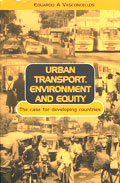The riddle of mobility
 "I have to have two cars to address my family's needs. To use public transport is an ordeal, and to use the streets as a pedestrian or cyclist is unthinkable. People in automobiles travel freely. Curbsides are filled with parked cars. Road space belongs to vehicles and the city belongs to no one." Which is this city?
"I have to have two cars to address my family's needs. To use public transport is an ordeal, and to use the streets as a pedestrian or cyclist is unthinkable. People in automobiles travel freely. Curbsides are filled with parked cars. Road space belongs to vehicles and the city belongs to no one." Which is this city?
It is a Brazilian city but perhaps any Indian city could fit the description.
Mobility is one of the most perplexing issues of our time. The culture of moving fast has grown rapidly and created more problems than it has solved. City planners and policymakers, busy with problems of vehicular pollution, hardly debate about traffic management.
This book urges for a change in mindset to tackle urban traffic problems in developing countries. It deals with traditional transport policies and related problems that threaten to divide communities, widen economic inequities, compromise safety and threaten public health.
The book relates the problem of traffic congestion with a loss in productivity. For intance, a study in Sao Paolo and Rio de Janeiro - two of the largest cities in Brazil - reveals that severe traffic congestion imposes on bus passengers, respectively, 118 million and 80 million additional hours per year.
The author, however, believes that the basic problem is the low availability of public transport and high number of private vehicles. But the solution lies neither in increasing road space nor restricting the number of vehicles.
The author uses accessibility, defined as the degree of ease with which people get to desired destinations, as the most direct measure of an effective transport system. He therefore argues that the actual distribution of roads between users will depend on their access to transport modes. Herein lies the solution.
For instance, users of private transport consume much more road space than those walking or using public transport. A comparison of per capita use of road space indicates that a person in a car can occupy 25 times more space than one in a bus.
This implies that those occupying more road space should pay for it. Yet, just the opposite happens. Subsidies on public transport systems are often termed wasteful.
This calls for a paradigm shift, by arresting the growth of private vehicles and encouraging the use of traditional non-motorised transport. The author insists that the planning process will have to be changed. Restraints on the undesirable use of private transport will have to be defined."
The book also discusses studies that show the severe constraint on road space in cities like Kolkata, where road area is just about 6 per cent of the total urban area. In contrast, Delhi stands at 21 per cent, comparable to cities like New York and London with road space of 22 and 23 per cent respectively. Yet, increasing traffic congestion poses a critical and perennial problem.
With road traffic bursting at the seams, it is time Indian planners too take this issue seriously.
